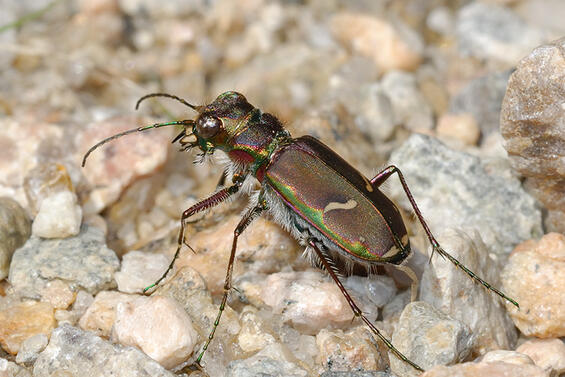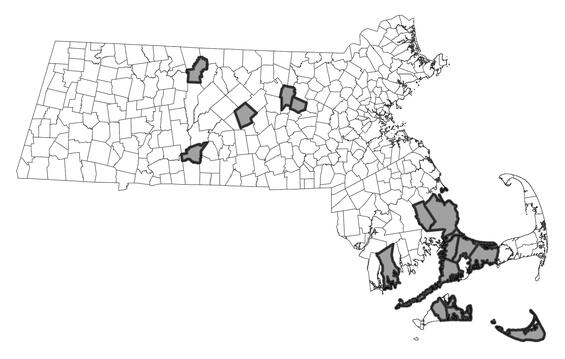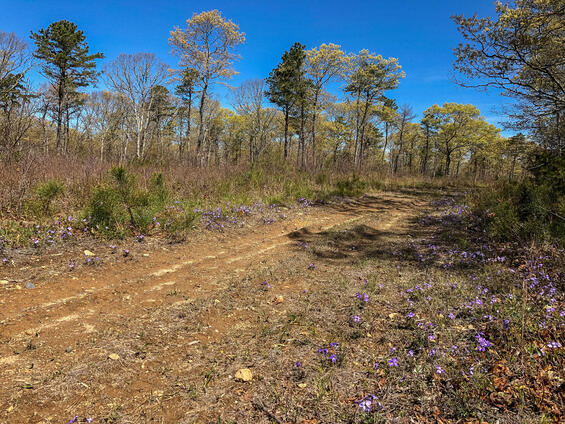- Scientific name: Cicindela purpurea
- Species of Greatest Conservation Need (MA State Wildlife Action Plan)
- Special Concern (MA Endangered Species Act)
Description

Purple tiger beetle (Cicindela purpurea)
Tiger beetles are so named because of their “tiger-like” behavior of chasing down and capturing prey with their long mandibles. The purple tiger beetle, or “cow path tiger beetle” (Cicindela purpurea), is 12-16 mm (0.5-0.6 in) in length (Pearson et al. 2015). Its color varies from iridescent, reddish or purplish-brown with iridescent green highlights to almost entirely iridescent green with iridescent, reddish or purplish-brown shading. There are distinct white maculations (spots and bands) on the elytra (wing covers). The claybank tiger beetle (Cicindela limbalis) is similar; however, the purple tiger beetle has middle maculations (the elongate bars in the middle of the elytra) that do not reach the outer edges of the elytra. The claybank tiger beetle has middle maculations that are complete, extending to the outer edges of the elytra. In addition, the purple tiger beetle very rarely has front maculations at the humeral angle (the “shoulders”), while the claybank tiger beetle almost always does.
Life cycle and behavior

In Massachusetts, the purple tiger beetle has a two-year life cycle (Leonard & Bell 1999). Adult beetles emerge in late summer and early autumn, overwinter, and are active again in spring and early summer, when mating and egg-laying occur. Larvae develop through the first summer and autumn, overwinter, and continue development in the second spring and summer. Pupation occurs by late summer, and adults emerge in late summer and early autumn of the second year.
Distribution and abundance
The purple tiger beetle ranges from New Brunswick south to northern Georgia, and west to North Dakota and Kansas (Pearson et al. 2015). In Massachusetts, the purple tiger beetle occurs primarily in the southeastern part of the state.

Distribution in Massachusetts. 2000-2025. Based on records in the Natural Heritage Database.
Habitat
In Massachusetts, the purple tiger beetle inhabits areas of sandy soils (or less often, sandy clay soils) with sparse or patchy vegetative cover, particularly sandplain grasslands and heathlands, as well as open areas within pitch pine-scrub oak barrens. Larval burrows occur in bare patches of sandy or sandy clay soils (Pearson et al. 2015).
Healthy habitats are vital for supporting native wildlife and plants. Explore habitats and learn about conservation and restoration in Massachusetts.

Open pitch pine-scrub oak barrens on sandy clay soil, habitat for the purple tiger beetle. Habitat managed by MassWildlife at Frances A. Crane Wildlife Management Area.
Threats
The purple tiger beetle is threatened by habitat loss and suppression of fire, which is needed to maintain the open vegetation structure of its habitat. Off-road vehicles kill adult beetles and larvae by crushing them, as well as cause extensive habitat damage by rutting consolidated sand, rendering it unsuitable for larval burrows. Aerial insecticide spraying is a potential threat. The effect of a warming climate may not be detrimental to this species in Massachusetts; its range extends south to Georgia, suggesting adaptation to warm temperatures.
Conservation
Land protection and habitat management are the primary conservation needs of the purple tiger beetle in Massachusetts. In particular, sandplain grasslands and heathlands, as well as pitch pine-scrub oak barrens should be conserved, restored, and managed to maintain habitat for this species and the entire suite of rare and threatened species dependent on such habitats.
Survey and monitoring
The distribution of the purple tiger beetle in Massachusetts is well documented. Known populations of this species should be surveyed to document persistence at least once every 25 years; every 10 years is more desirable when practicable.
Management
Management of sandplain grasslands, heathlands, and pitch pine-scrub oak barrens benefits a suite of rare and threatened species, and habitat condition should be monitored and management adapted as needed. Where the purple tiger beetle occurs in pine barrens habitat, sparsely vegetated openings and patches of bare sand are of particular importance.
Research needs
The natural history and conservation needs of the purple tiger beetle are relatively well understood. However, the future effects of a warming climate on this species are unpredictable and should be documented.
References
Leonard, J.G. and R.T. Bell. 1999. Northeastern Tiger Beetles: A Field Guide to Tiger Beetles of New England and Eastern Canada. CRC Press, Boca Raton, Florida. 176 pp.
Pearson, D.L., C.B. Knisley, D.P. Duran, and C.J. Kazilek. 2015. A Field Guide to the Tiger Beetles of the United States and Canada. Oxford University Press, New York, New York. 251 pp.
Contact
| Date published: | April 15, 2025 |
|---|